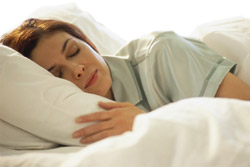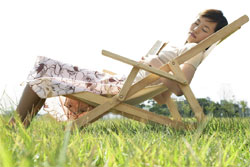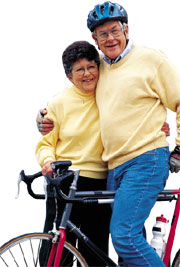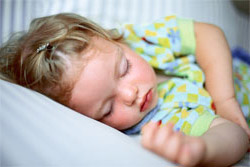- The importance of sleep and sleep hygiene
- Categories of sleep hygiene measures
- Additional sleep hygiene measures in children
The importance of sleep and sleep hygiene

- Having sufficient energy and alertness for daytime functioning;
- Memory;
- The immune system;
- The cardiovascular system; and
- The function of many endocrine/hormone systems that regulate aspects of metabolism including insulin production and regulating blood glucose levels and appropriate hunger and satiation responses.
Thus, sleep is crucial to daytime functioning, cardiovascular health and metabolism. Individuals who suffer from sleep deprivation or insomnia are more likely to suffer from cardiovascular disease, weight gain and type II diabetes.
The amount of sleep, sleep quality and timing of sleep are all determined by many everyday activities and attitudes. In the developed world, sleep time is becoming increasingly confined to the time left over after family, work and social commitments. As a result, insomnia, daytime sleepiness and other sleep symptoms are also rising and have a huge effect on daytime functioning and productivity.
The aim of sleep hygiene is to translate what is known about the biology of sleep into practical advice for promoting sleep through lifestyle and environmental changes.
For further information on sleep, see sleep physiology.
Categories of sleep hygiene

- Changing the sleep environment – so that the bed is comfortable and the room is warm, quiet and dark;
- Improving sleep-wake patterns – increasing physical daytime activity and preparing for sleep (e.g. by winding down, taking a warm bath) and having regular times for meals and sleep and avoiding napping; and
- Changing drug and food intake – reducing consumption of caffeine and other stimulants late in the day and changing the timing of diuretics to reduce the need for nighttime urination.
Sleep environment
Achieving the ideal sleeping environment is crucial to getting a good night’s sleep.
A comfortable mattress and bedding that prevents tossing and turning during the night is essential for initiating sleep and preventing arousal during the night.
The bedroom should be as dark as possible when sleeping. Heavy, thick and dark curtains with a block-out lining can assist with blocking out streetlight and noise.
Noise can delay the onset to sleep and also arouse one from sleep during the night. Thick curtains, roller shutters, double-glazed windows and earplugs can all assist to decrease noise exposure while sleeping. The noise threshold for arousal varies between individuals and also changes with age.
The ideal ambient temperature for promoting sleep is 18°C. Temperatures below or above 18°C can result in disrupted sleep.
Remove any disruptive items from the bedroom such as items that have a clock display – e.g. clocks, mobile phones and radios. Clock watching can induce anxiety and is activating and counterproductive for sleep.
Do not allow children and pets to sleep in your bed as this can result in fragmented and less restful sleep.
The brain can associate areas (i.e. the bedroom) with activities (i.e. sleeping). This association needs to be reinforced. The bedroom should not be used as the lounge room. Activities such as knitting, reading, computer work, watching television and making phone calls should not be undertaken in the bedroom. The bedroom/bed should be used for intimacy and sleeping only.
Sleep-wake cycles

Moderate-intensity physical activity during the day can be very effective at alleviating insomnia. A study found that 30 minutes of daily exercise was as effective at improving sleep as benzodiazepines (a light tranquiliser medication). However, physical activity should not be done within 3 hours of going to bed, as exercise increases alertness during the activity and also for 3 hours following activity.
Regimented times for going to bed, going to sleep, waking up and getting out of bed will assist in tuning one’s “body clock” to the sleep-wake cycle. “Morning people” can sleep longer by going to bed earlier in the evening, while “night people” can sleep for longer by sleeping later into the morning.
Exposure to natural light during the day is important for melatonin production and for synchronising circadian rhythms. Sunlight exposure early in the day is particularly helpful.
Daytime napping should be minimised or avoided if possible as naps can disrupt the sleep-wake cycle in individuals that experience sleeping difficulties.
Leaving the bed and bedroom when one is unable to initiate sleep will reduce anxiety and help one to mentally associate the bed and bedroom with sleep alone rather than other activities such as watching television, reading or thinking.
A warm bath about 1-2 hours prior to bedtime causes the body’s temperature to rise and then fall thereby promoting sleep.
Meditation and progressive muscle relaxation techniques prior to bedtime can assist with relieving muscle tension, anxiety, stress and worry. Muscle tension and all of these thoughts and emotions can prevent the onset of sleep. Another great way to alleviate nighttime thoughts and stress is to write down of your thoughts, concerns and “to do” lists prior to going to bed. This will put the mind at ease and assist the mind and body to relax so that sleep can be initiated.Yoga, pilates and deep-breathing exercises are also good rituals to perform prior to going to bed, as these activities relax both body and mind.
A sleep diary can be kept to gain greater insight into your sleep and wake cycles. However, as this involves clock-watching a sleep diary should only be kept for a short period (1-2 weeks) to monitor sleep. It can then be used a few months down the track to determine if these behavioural modifications have improved your sleep.
Food and drug habits
Items to avoid
Avoid stimulants (including caffeine) late in the day, at least 4-6 hours before bedtime, as they can prevent the initiation of sleep.
Diuretics should also be avoided late in the day, at least 4-6 hours prior to bedtime, as the need for nighttime urination can lead to arousal from sleep and sleep disruption. You should always go to the toilet prior to getting into bed to diminish the need for nighttime urination.
Avoid using alcohol to promote sleep as it has a number of detrimental effects on sleep. It increases the need for nighttime urination, causes fragmented sleep and a wake up earlier in the morning. Alcohol also exacerbates snoring and sleep apnoea.
Avoid high protein foods in the evenings. Proteins contain the amino acid tyrosine that promotes wakefulness.
Hunger can keep one awake so eat an adequate meal in the evening. Large meals can cause reflux and heartburn that can also drive wakefulness.
The stimulating effects of nicotine in cigarettes result in sleep loss in smokers. Quitting smoking is not only of immense benefit to overall health but also eliminates the sleep loss associated with nicotine use.
Items that promote sleep
Increase your intake of dietary sources of tryptophan (the precursor for melatonin). Tryptophans can be found in carbohydrates and milk products and also in bananas, peanuts and figs. Warm milk drinks before bedtime are particularly useful at promoting the onset of sleep.
There are many herbal and dietary supplements that have been advocated as sleep aids. These include valerian root, lavender, passionflower, St John’s wort, glutamine, niacin and tryptophan. There is sufficient evidence of benefit for all of these except valerian root.
Medications should be taken as directed by your health care professional and indicated on the packaging.
Additional sleep hygiene measures in children

Developmentally appropriate bedtimes are important, as going to bed too early can result in a delayed sleep onset. By 6 months of age, all infants should be able to sleep through the night without feeding and should fall asleep on their own. Between 6 months and 2 years of age, approximately 13 hours of sleep per day is required. Children between 2 and 3 years of age need approximately 12 hours of sleep per day. Between 3 and 5 years of age, children require about 11 hours of sleep. Children between 5 and 9 years of age require about 10.5 hours of sleep and they should no longer be napping. Between 9 and 13 years of age, approximately 10 hours of sleep is required per day.
The amount of sleep a child requires is highly individual. If your child is sleeping for less than the recommended amount of time but is alert and not tired during the daytime, then your child is getting sufficient sleep. If your child is sleeping for the recommended amount of time but is showing signs of daytime fatigue and excessive tiredness, then your child may require more sleep than the recommended amount.
Teenagers require 9 hours of sleep per day, however they have trouble getting enough sleep both because of their busy schedules and because their biology programs them to want to stay awake later into the night and sleep later in the morning. This preferred sleeping pattern does not mesh well with school schedules.
Consistent sleep schedules and routines (bedtimes and times for awakening in the morning) on school days, weekends and during school holidays is important for synchronising circadian rhythms.
As in adults, an appropriate sleep environment is important for a restful sleep in children.
Stimulating activities such as watching television, playing TV or computer games and competitive board games should be avoided prior to bedtime as they promote alertness and can delay the onset of sleep.
Stimulants such as caffeinated drinks and sugars should be avoided late in the day as these have stimulating effects and can also delay sleep.
More information
 |
For more information about sleep, including how much is good for you, tips for getting more sleep, and sleep disorders, as well as some useful videos, see Sleep. |
References
- Shneerson JM. Sleep Medicine: A guide to sleep and its disorders (2nd edition). Oxford: Blackwell Publishing; 2005. [Book]
- Sleep Health Australia. Wake up Australia: The value of healthy sleep [online]. Barton, ACT: Access Economics; October 2004 [cited 15 June 2010]. Available from: URL link
- Ringdahl EN, Pereira SL, Delzell JE Jr. Treatment of primary insomnia. J Am Board Fam Pract. 2004;17(3):212-9. [Abstract | Full text]
- Ebben MR, Spielman AJ. Non-pharmacological treatments for insomnia. J Behav Med. 2009;32(3):244-54. [Abstract]
- Advice on sleep hygiene. [online]. Melbourne, VIC: Therapeutic Guidelines; November 2008 [cited 14 June 2010]. Available from: URL link
- King AC, Oman RF, Brassington GS, et al. Moderate-intensity exercise and self-rated quality of sleep in older adults. A randomized controlled trial. JAMA. 1997;277(1):32-7. [Abstract | Full text]
- Centre for Clincal Interventions. Progressive muscle relaxation [online]. Northbridge, WA: Western Australian Government Department of Health; 2007 [cited 14 June 2010]. Available from: URL link
- Centre for Clinical Interventions. Calming technique [online]. Northbridge, WA: Western Australian Government Department of Health; October 2003 [cited 14 June 2010]. Available from: URL link
- Centre for Clinical Interventions. Sleep hygiene [online]. Northbridge, WA: Western Australian Government Department of Health; April 2008 [cited 14 June 2010]. Available from: URL link
- Sleep hygiene [online]. Kent Town, SA: Sleep Disorders Australia, South Australian Branch; 2006 [cited 14 June 2010]. Available from: URL link
- Ramakrishnan K, Scheid DC. Treatment options for insomnia. Am Fam Physician. 2007;76(4):517-26. [Abstract | Full text]
- Mindell JA, Owens JA. A Clinical Guide to Pediatric Sleep: Diagnosis and management of sleep problems (2nd edition). Philadelphia: Lippincott Williams and Wilkins; 2009. [Book]
All content and media on the HealthEngine Blog is created and published online for informational purposes only. It is not intended to be a substitute for professional medical advice and should not be relied on as health or personal advice. Always seek the guidance of your doctor or other qualified health professional with any questions you may have regarding your health or a medical condition. Never disregard the advice of a medical professional, or delay in seeking it because of something you have read on this Website. If you think you may have a medical emergency, call your doctor, go to the nearest hospital emergency department, or call the emergency services immediately.







